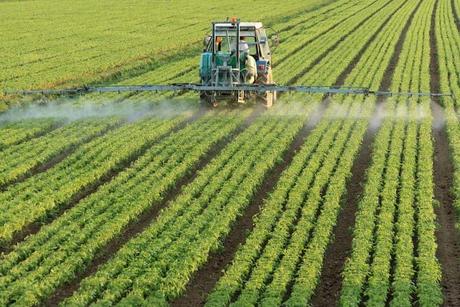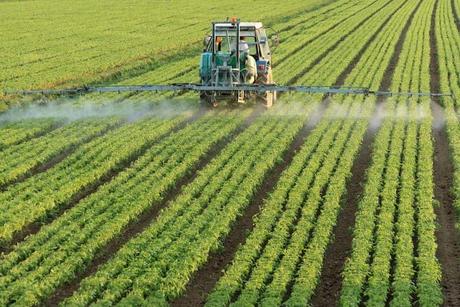The farmers use pesticides, fungicides, fertilizers directly on the farm that contaminate water and cause atmospheric deposition. The runoff from the farms is the main reason why water bodies are polluted. Rainwater enables the sediment of the farms to drain to nearby water bodies like lakes and rivers. Too much sediment can clog the water and can also clog the gills of fishes.
Farmers apply fertilizers to farms, and that carries phosphorous, nitrates, and potassium. These are then carried to water bodies that can cause algae blooms, which ruins the swimming opportunity for aquatic beings and create a foul smell. Excessive grazing by livestock can cause soil erosion, which is carried to the nearby water body, thereby transporting nutrients, pesticides, and heavy metals.

Which Farming Activity Contributes Most to Water Pollution?
The use of pesticides in farming causes the highest amount of water pollution. When the usage of pesticides compared in various countries like Canada, Iceland, Luxembourg, Belgium, it points to the fact that the usage of pesticides brings the highest amount of water pollution from farming activities. Apart from a few countries, maximum countries are affected by pollution by agriculture, which is self-explanatory.
The nitrates and phosphates in the fertilizers are also reasons for the contribution of pollution to water from agriculture. Almost fifty percent of the OECD countries concluded that the concentration of pesticides and nutrients in the groundwater and water surface near agricultural lands are tremendously high.
Pollution across the estuarine and coastal agricultural land is notably high because of algal blooms. The red tides and dead zones damage marine life that includes commercial fisheries across the coastal waters in countries like Australia, Korea, Japan, the US, and the countries across the Mediterranean, Baltic and the North Sea.
Some studies in Canada show that by using improved farming practices, the level of phosphates in certain places is decreasing. It can also reduce the process of eutrophication or excessive richness in nutrients. In the case of Australia, the water quality entering the Great Barrier Reef is of grave concern.
The dry regions of Queensland are the primary source of pollution, but now the farmers have adopted various techniques to reduce the amount of water pollution. The farmers of the OECD countries have started to respond to the environmental farm management practice and have addressed various consumer concerns.
What are the Types of Wastes of Water Pollution Associated With Agriculture?
Farming activities involve enriching the land by making it fit for growing plants. The more we take from the earth, it has to be given back in the form of nutrients. Now, certain nutrients have to be added for making the farm capable of growing crops again. Some ingredients are considered as wastes that are used on the farm.
1. Pesticides
The farmers use herbicides, insecticides, fungicides, bactericides, and many more that are used in the form of DDT. They are applied to crops to avoid infestation by various pests. Various countries have banned the usage, but still, they are used to prevent infestation, thereby reducing the challenges of harming crops.
2. Nutrients
Farmers use Nitrogen and Phosphorous present in the chemical and organic fertilizers coming from animal excretion.
3. Sediments
Formation of deposit occurs as a suspended solid in the water of the ponds.
4. Pathogens
Pathogens like E. Colli are formed from the usage of organic manures, and they are treated as waste.
5. Organic Manure
Organic manure from animal waste is used on the crops. When the crops are exhausted, the remains get degraded after stubble burning.
6. Other Emerging Pollutants
These include hormones, feed additives, and drug residues. All these substances, when emerging into the water of ponds and rivers, are treated as pollutants.
How do Agricultural Activities Contribute to Water Pollution?
The growth of crops occurs due to the extensive usage of pesticides, whose global market is more than 35 billion dollars per year. Countries like Argentina, South Africa, Malaysia and Pakistan have experienced double-digit achievement in crops due to the usage of pesticides.
In most of the high-income countries having an emerging economy, agricultural pollution has taken over in the coastal and inland water bodies.
The nitrate from agriculture is the most common chemical contaminant of the water bodies. The accumulation of sediments and eutrophication leads to distortion of fisheries and biodiversity in lakes and also coastal waters.
It has been observed that about one-fourth of the entire food production is lost, and the reason is that 23 percent of the water used in crops is affected by the usage of fertilizer and pesticides. Around 38 percent of the water bodies around the European Union are affected by pollution due to agriculture.
In China, the scenario is that a larger portion of water body pollution occurs from nitrates. For OCED countries, water pollution resulted from agriculture costs billions of dollars every year.
How Does Water Pollution Affect Food Production?
During various stages of the production process, fresh fruits and vegetables usually come in contact with water. The contaminated water that is used during crop production, harvesting, and processing can lead to health issues.
The various potential food production points where contaminated water sources can affect crop production include:
1. Chemical application
The crops with contaminated water used for pesticide and herbicide applications. The water that is used for mixing the chemicals should be of the appropriate quality that it does not affect the crops.
2. Irrigation
The water used for irrigation is contaminated with the chemicals. Therefore, the water used in the case of irrigation should be of the best quality.
3. Worker’s hygiene
While the workers engage in farming, there is a lack of potable water for the cleanliness of hands. There should be some established handwashing and hygiene policy for farmworkers.
4. Food processing
The crops should be washed with quality water in the final process. The water should be drinking water and of course not recycled. People consuming food exposed to polluted water could be prone to foodborne diseases. The water quality is crucial for the well-being of crops. For keeping microbes out of water sources, growers must adopt practices that assure the best quality water.
What Can be Done to Prevent Water Pollution From Agriculture?
There are various ways to deal with water pollution from agriculture. Here are some preventive measures.
1. Policies and incentives
There should be the right policies and incentives to encourage diets that are more sustainable and healthy. There will be a moderate increase in food demand. Financial incentives like taxes and subsidies on food and coupons for consumers can positively influence dietary behavior. Loss of food should be reduced to reduce an impact on the environment and essential resources.
2. On-farm responses
Inside farms, measures should be taken to reduce the risk of water pollution due to the utilization of organic and inorganic fertilizers. The type, amount and timing of the application to crops should be limited and optimized.
Protection zones should be established along the surface watercourses. Buffer zones are to be built around the farms, which will reduce the amount of pollution migration of pesticides and fertilizers to the surrounding water bodies.
3. Off-farm responses
Building buffer strips along the farm is an innovative response that can reduce the amount of pesticide and fertilizer entering the surrounding water bodies. Vegetated filter strips at the margin of farms and rivers decrease the concentration of pollutants entering the gateway.
When crops, livestock, trees and fish can be managed effectively, it can provide the best solution. The output of livestock can be used for plants to control the pollution of water bodies. This method can also help reduce pollution and the utilization of resources in the best possible way.
Resources:
https://www.britannica.com/science/water-pollution
http://www.fao.org/land-water/news-archive/news-detail/en/c/1032702/
https://www.cdc.gov/healthywater/other/agricultural/contamination.html


